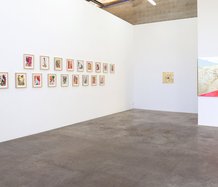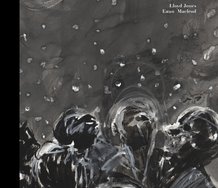Andrew Paul Wood – 11 September, 2020
Into the 2000s. I love the stereo speaker sound works, clustered together like Warhol's 'Brillo Boxes', covered in brown packing tape or painted a fleshy cartoonish pink. I think they are always going to be my favourite entry in the Reddaway oeuvre. Like alchemical homunculi or the golem of Jewish folklore, they are the imitation of animation. Their aesthetic retains that arte povera shabbiness of Reddaway's 1990s work, but with a more lo fi, lo stakes disposability.
Richard Reddaway
It does no harm to wonder / The Body of the Work
Contributions from assorted essayists, interviewers and designers
184 pages, plus pageworks, boxed (ed. 200)
Aratoi Wairarapa Museum of Art and History, and Toi Rauwhārangi College of Creative Arts, Massey University, 2020
ISBN: 978-0-47-353262-8
Richard Reddaway is one of those unusual artists—particularly rare in New Zealand—who is overtly political and philosophical in his content, but without that overwhelming the work’s aesthetic experience. He’s probably best known as a sculptor and installation artist, but his practice also incorporates photography, drawing, and the written word. Philosophically he is interested in the social relationships between art history, cultural theory, contemporary art, and chaos theory (non-linear dynamics). His art is unapologetically rooted in the politics of the left and he teaches at the Massey University school of art.
Following his exhibition, The Body of the Work / It does no harm to wonder at Aratoi Wairarapa Museum of Art and History this year—a survey of his sculpture from the mid-1980s, photomontages from the 1990s, and new work—he has brought out a limited edition publication, It does no harm to wonder / The Body of the Work. It’s a remarkable overview of thirty-five years of artistic practice, striking in its bewildering diversity of forms and modes. It is bloody difficult to write about because, for all the roughly linear narrative, there is much wildly various territory to cover.
This is a remarkable publication, or rather a collection, as there is a lot packed into the box, including sticker sheet pageworks of Reddaway‘s eyes, two of which are missing because they’re on the box. Edited by Kate Linzey, and designed by Jo Bailey and Anna Brown, it includes texts by Tim Corballis, Julian Holcroft, Owen Connors, Andrew Gibbons and Emit Snake-Beings, Bridget Riggir-Cuddy and an interview with Sophie Jerram. It also includes a booklet of Reddaway’s writings, Tales from elsewhere / Fairytales for socialists (the title apparently punning on William Morris’ 1890 socialist-utopian novel News from Nowhere), designed by Sarah Hall. All, more or less, friends and fellow travellers.
What this book is not, is straightforward. Don’t expect to have your hand held and be gently guided through an integrated oeuvre and career. The format is every bit as chaotic as the art itself, and I confess a certain amount of annoyance with many of the texts because their tone and tropes just remind me of that sort of cool kids edgy, indulgent, self-congratulatory, intimate obliqueness of 1990s art writing—which is perhaps a liability with the earnest haut-seriousness of young artists today.
The aesthetic of the book is a little Bauhaus, a little punk collage, a little Russian constructivist; telegraphing the underlying politics through art history, and this extending to the pageworks inside (some elaborately folded, playfully referencing the avant-garde political aesthetics of the early twentieth century). Politics are a consistent thread in Reddaway‘s work, this guiding us through the HART Anti-Springbok Tour protests, Rogernomics, and the cultural anxiety of being Pākehā heading into an uncertain future.
In that, he has a lot in common with his Ilam art school contemporaries — though he emerged with others like Grant Lingard and Chris Braddock five years before the ‘Pencilcase School.’ Both groups helped create a new kind of New Zealand postmodern Historia in an attempt to interpret their times. It is no coincidence that the book is dedicated to artist and educator Tom Taylor who was a significant influence on the sculptors amongst them.
Born to English parents, Reddaway‘s utopianism stems from his belief that Aotearoa, like the Americas, is what he calls “a new Baroque culture sites of cultural complexity where the dominant Western paradigm rubs against other ways of being in the world.” When he says “Americas” he is thinking of the baroque traditions of Latin America and its fusion of indigenous influences that made the Baroque the first truly global aesthetic movement.
This is the Baroque in its Deleuzian sense of a metaphorical folding of infinite possibility bridging the self and the world, through which Reddaway wants to find a way out of the exploitative neoliberal system towards something that “might be socialism”. Here Reddaway has found a spiritual connection with the passionately political and social art of Latin America; the residencies in Mexico and Ecuador, and the collaborative exhibition Tales from Elsewhere in Peru.
Things kick off at Ilam in 1985 with Zig-zag, Four-Square and 3-Up, three endlessly reworkable sculptures made from wood, clothing and hessian sacking. They evoke pathetic, ramshackle human figures, or prosthetic-esque parts thereof — Zig-zag has a human centipede quality to it. Of them Reddaway (I think it’s Reddaway though it’s not made clear) says:
“…these works reflected the context of their times: punk and the Dunedin sound; Bastion Point and the anti-Springbok tour protests; German neo-Expressionist painting and New British sculpture; the radical economic reforms introduced by the fourth Labour government.”
Corballis’ jumping off point to discuss these works and Reddaway’s “Romanesque” collages is, at first, a surprising one: Diego Rivera’s mural Man, Controller of the Universe (1934) that once graced 30 Rockefeller Plaza in New York, until a controversy surfaced over a snuck-in portrait of Lenin. The connection is a rather abstruse one based on socialist body metaphors that articulate an identity at a historical point in time, but not really (and as Corballis notes, Reddaway doesn’t even like the mural).
I struggle with Holcroft’s script for an imaginary documentary dialogue between the artist, Holcroft himself, the Mongrel Mob, Walter Benjamin, Ridley Scott, and the late Lingard—among others. The posturing gets a tiny bit in the way of the big points about Holcroft’s and Reddaway’s interest in science fiction at art school and the relationship to body horror. But I suppose that makes sense — Reddaway’s works are themselves indulgent, embracing the extraneous clutter as part of their Baroque-ness.
The clearest and most informative voice is inevitably Reddaway’s, and it’s really left to him to build the bridge to the photocollages being exhibited in Forbidden Planet at 23A gallery in Auckland in 1996, and to the 1956 SF movie Forbidden Planet (based on Shakespeare’s The Tempest) as a metaphor for the rapidly changing, aspirational, neoliberal Auckland rich in growing alienation.
Into the 2000s. I love the stereo speaker sound works, clustered together like Warhol’s Brillo Boxes, covered in brown packing tape or painted a fleshy cartoonish pink. I think they are always going to be my favourite entry in the Reddaway oeuvre. Like alchemical homunculi or the golem of Jewish folklore, they are the imitation of animation. Their aesthetic retains that arte povera shabbiness of Reddaway’s 1990s work, but with a more lo fi, lo stakes disposability. Those slightly younger and nerdier than I, can possibly see a clairvoyant anticipation of Warhammer 40K’s Chaos Noise Marines, for in their own way, the speaker works have an insatiable sensory void the latter cannot fill nor wound with sound.
Gibbons and Snake-Beings highlight the ability of DIY makers and make-doers to upend the capitalist-consumer neoliberal order with reference to that old Philip K Dick chestnut “kibble.” This almost segues into the relational and communal aspects of such a philosophy in relation to Reddaway’s practice, but falls short of connecting to the art. About the time Nicolas Bourriaud coined the phrase “relational aesthetics” in 1998, Reddaway had already been doing it for a decade or so. The more recent wearable sculptures or mask-like paintings—with their links to Franz West and Franz Erhard Walther—and the collaborations with community weavers, tatters, embroiderers and knitters, are the latest iteration of those principles.
It’s not until right near the end of the publication that a serious attempt is made to address the survey exhibition, and what such an overview of Reddaway’s work might actually signify. Riggir-Cuddy skilfully brings these threads together with dry and functional efficiency, giving the much needed context that I had been craving. In combination with the following interview of Reddaway by Jerram we actually get the specific philosophical meat of the artist’s practice. Reddaway’s work is about transcending the limits of imposed categories and labels (for the ease of being controlled and sold things), and constructing new, engaged identities, echoing E. M. Forster’s plaintive plea, “only connect”. Art as social empathy.
Andrew Paul Wood

 Advertising in this column
Advertising in this column Two Rooms presents a program of residencies and projects
Two Rooms presents a program of residencies and projects



This Discussion has 0 comments.
Comment
Participate
Register to Participate.
Sign in
Sign in to an existing account.